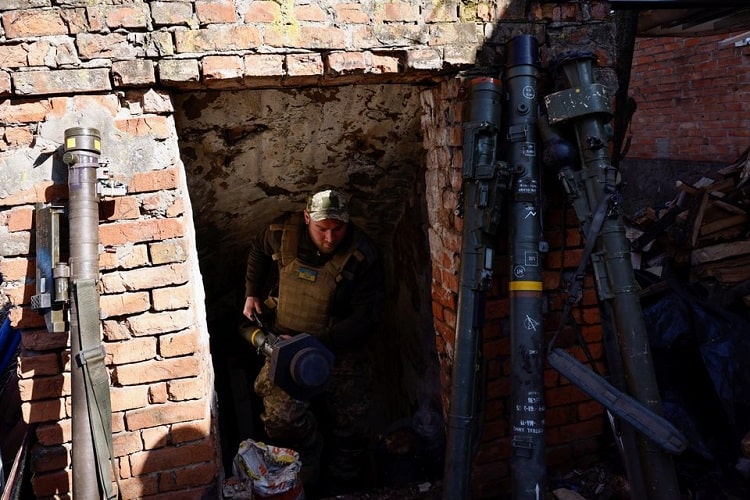Russian forces attacked northern and southern stretches of the front in Ukraine’s eastern Donbas region on Friday, even as Kyiv said Moscow’s assault was flagging near the city of Bakhmut.
Ukrainian military reports described heavy fighting along a line running from Lyman to Kupiansk, as well as in the south at Avdiivka on the outskirts of the Russian-held city of Donetsk.
Both areas have been major Russian targets in a winter campaign to fully capture Ukraine’s industrialised Donbas region. The offensive has so far yielded scant gains despite the death of thousands of troops on both sides in the bloodiest fighting of the war.
We're now on WhatsApp. Click here to join.
At a Ukrainian artillery position in lush pine forests behind the northern stretch of the front, troops fired 155 mm rounds from a French TRF-1 howitzer towards a highway used as a supply road for Russian-held Kreminna.
“Luckily we are holding the same position,” a soldier using the call sign “Greenwich” told Reuters. “Because we are facing a very strong enemy with very good arms. And it’s a professional army: airborne troops.”
Upon receiving orders with specific coordinates, the crew swiftly positioned themselves around the gun, removed its camouflage, aimed, loaded, and fired. After firing three rounds, they lowered the barrel, covered it back up, and returned to the safety of the bunkers hidden in the forest, awaiting further instructions. The distant sounds of artillery and small arms fire could still be heard.
Despite the intense fighting, the front lines have remained almost unchanged since November. In the latter half of 2022, Ukraine managed to recapture a significant amount of territory. However, since then, they have primarily maintained a defensive stance, while Russia has launched attacks with the help of hundreds of thousands of recently drafted reservists and prisoners.
As the winter season gives way to spring, the main concern in Ukraine is whether Russia can continue its offensive, and whether Ukraine can launch a successful counterassault to reverse the current momentum.
On Thursday, the commander of Ukrainian ground forces said Russia’s assault on Bakhmut, a small city that has been the focus of the biggest battle of the war, appeared to be losing steam and Kyiv could go on the offensive “very soon”.
‘PEOPLE PUSHED TO THE VERY LIMITS’
For now, Ukrainian forces are still focused on preventing the Russians advancing along more than 300 km (185 miles) of Donbas front, from Kupiansk in the north to Vuhledar in the south.
“All day yesterday the enemy tried to attack in the Avdiivka direction,” said Oleksiy Dmytrashkyvskyi of Ukraine’s Tavria military command, responsible for southern areas. “Shelling of Avdiivka does not stop – artillery, rockets, mortars. It is sad to see how people survive there who do not want to leave, they are mostly elderly people.”
Serhiy Cherevatyi, spokesperson for the East command defending the front further north, said Russia’s main focus lately had been on the stretch from Kupiansk to Lyman, territory recaptured by Ukrainian forces last year.
Both said the Russians were reinforcing after heavy losses. There was no similar update from the Russian side, which has long claimed to be inflicting heavy casualties on the Ukrainians.
In Bakhmut itself, Ukrainian troops who weeks ago had appeared likely to pull back have instead dug in, a strategy some Western military experts say is risky because of the need to conserve forces for a counterattack.
The International Committee of the Red Cross said some 10,000 Ukrainian civilians, many elderly and with disabilities, were clinging on in horrific circumstances in Bakhmut and surrounding settlements.
“They are living in very dire conditions, spending almost the entire days in intense shelling in the [underground] shelters,” the ICRC’s Umar Khan told a news briefing by video link from Dnipro, in Ukraine.
“All you see is people pushed to the very limits of their existence and survival and resilience.”
The United Nations issued its latest report on human rights abuses in the war, confirming thousands of civilian deaths, which it describes as the tip of the iceberg, as well as disappearances, torture and rape, mostly of Ukrainians in Russian-occupied areas. Russia denies carrying out atrocities in what it calls a “special military operation”.
RUSSIAN ECONOMY BURDENED
In Kostiantynivka, west of Bakhmut, a Russian missile slammed into a refuge offering a warm shelter for civilians, killing at least three women, local officials said. Photographs released by emergency services showed a wrecked building. A mattress protruded from the rubble. There was no immediate Russian response to the reports.
In the northern Sumy region, an administrative building, a school building, and residential buildings were among those damaged from Russian shelling that killed two civilians, President Volodymyr Zelenskiy’s office said.
Russia said its forces had destroyed a hangar housing Ukrainian drones in the Odesa region in the south.
Russia invaded Ukraine in February 2022, saying Ukraine’s ties to the West were a security threat. Since then, tens of thousands of Ukrainian civilians as well as soldiers on both sides have been killed. Kyiv and the West call the war an unprovoked assault to subdue an independent country.
Dmitry Medvedev, a hardline Kremlin official, said Moscow required a demilitarised zone around Ukrainian territory it claims to have annexed, and would otherwise battle deep into Ukraine.
While Russia’s invasion has wreaked colossal damage in Ukraine, increased defence spending, Western sanctions and the loss of hundreds of thousands of young men from the workforce have also caused economic upheaval at home.
The Social Policy Institute at Moscow’s Higher School of Economics found in a study released this week that, even in its most optimistic scenario, real incomes would only exceed 2021 levels by 2% by the end of the decade. A middle class that has grown since Vladimir Putin became president in 2000 would shrink markedly.
“Thus, even in the most favourable development of events, one can expect the deterioration of the middle class and of the population’s social and psychological well-being,” the authors wrote.





